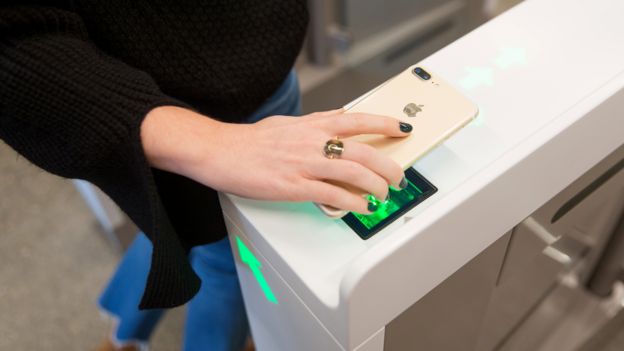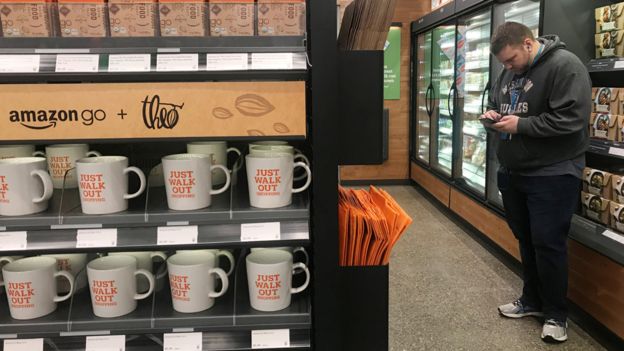커다란 슈머마켙에서 필요한 물건이나 Groceries를 쇼핑해서 카트에 듬뿍 쌓아놓고, 마지막에는 Cash Gegister앞에 줄서서, 차례를 기다렸다가 차례가 되면 Casher에게 Check up 받고, 물건값을 지불하고 주차장에 있는 Car로가서 Handle을 돌려 집으로 향하게 되면 쇼핑은 마치게되는 셈이다.
그런데 그러한 쇼핑 concept은 머지 않아 확 바뀌어서, 쇼핑객은 마켙으로 들어오면서, 입구에 설치되여 있는 Gate에서 자기 소유의 Credit Card 또는 이와 상응한 카드를, 지하철을 이용할때 Gate에서 카드를 Scann한후 Gate가 열리면 지하철로 들어가듯이, 마켙안으로 들어가서 거기서 부터 필요한 물건들을 쇼핑백에 집어 넣고, 쇼핑이 끝나면 그대로 쇼핑몰을 나와서 집으로 향하면 그걸로서 쇼핑완료다.
현재는 Sample Case로 Amazon에서 오늘 즉 월요일부터 Cash대에서 Check out절차를 걸치지 않고, 위에서 언급한데로 아무도 없는 쇼핑장을 빠져 나오면 되는, 슈퍼마켙을 개장하여 영업을 시작하게 됐다고 한다.
Amazon에서는 이러한 쇼핑 Concept을 현실로 옮기는 시험 케이스로, Seattle에서 Amazon 직원들을 상대로 지난 1년간 슈퍼마켙을 운영해온결과, 가능성을 발견하고, 실제 고객들을 상대로 오늘부터 장사를 시작한 것이다. 이러한 쇼핑 Concept이 잘 발전되면, 북미 대륙을 비롯한 전세계가 이러한 쇼핑 Pattern으로 발전될것으로 예측하는것은 어렵지 않을것 같다.
쇼핑몰안의 천장에는 아주 민감한 전자감응기들이 부착된 Security Camera들이, 쇼핑객들이 필요한 물건을 집어서 백에 넣는 순간을 전부 인지하여, 아까 입장할때 입장 Pass로 이용했던 카드계좌에 차곡 차곡 쌓이고, 월말이 되면 고지서가 고객의 주소로 전달 되는 것이다.
시험기간 동안에 발견된 문제점은 외모가 비슷한 고객을 식별하는데 약간의 혼선이 있었고, 또 다른 문제는 어린 아이들이 물건을 집었다가 필요치 않을 경우 원래의 자리에 놓치않고, 다른곳에 놓았을 경우에는 제대로 인식을 못하는 약간의 문제점이 있었다고 한다.
필요한 물건들을 Shelves에서 집어서 백에 넣고 집으로 향하는 "쇼핑의 미래"가 꿈이었었는데, Amazon에서는 마침내 그 꿈이 현실로 우리앞에 왔거나, 아니면 최소한 그러한 현실의 세상에서 시험을 할수 있게 됐다는 설명이다.
필요한 물건들을 Shelves에서 집어서 백에 넣고 집으로 향하는 "쇼핑의 미래"가 꿈이었었는데, Amazon에서는 마침내 그 꿈이 현실로 우리앞에 왔거나, 아니면 최소한 그러한 현실의 세상에서 시험을 할수 있게 됐다는 설명이다.
BBC의 뉴스를 아래에 옮겨 놓았다.
In a move that could revolutionise the way we buy groceries, Amazon opens its first supermarket without checkouts - human or self-service - to shoppers on Monday.
Amazon Go, in Seattle, has been tested by staff for the past year.
It uses hundreds of ceiling-mounted cameras and electronic sensors to identify each customer and track what items they select.
Purchases are billed to customers' credit cards when they leave the store.
On entering the store, shoppers walk through gates similar to those in the London underground, swiping their smartphones loaded with the Amazon Go app.
Then they are free to put any of the sandwiches, salads, drinks and biscuits on the shelves straight into their own shopping bags.
There's no need for a trolley or basket, since you won't be unpacking it again at the till. In fact, unless you need to be ID-checked for an alcohol purchase, there's also no need for any human interaction at all.
With the help of sensors on the shelves, items are added to customers' Amazon Go account as they pick them up - and delete any they put back. And an electronic receipt is issued as they exit.
- Virtual assistants and mobile shops: the changing face of shopping
- Amazon finally arrives in Australia
The store opened to employees of the online retail giant in December 2016 and had been expected to allow the public in more quickly.
But there were some teething problems with correctly identifying shoppers of similar body types - and children moving items to the wrong places on shelves, according to an Amazon insider.
 REUTERS
REUTERS
Gianna Puerini, head of Amazon Go, said the store had operated well during the test phase: "This technology didn't exist - it was really advancing the state of the art of computer vision and machine learning."

How does it work?
Grab-and-go shopping has been the "future of retail" for some time now.
But now Amazon believes its time has come - or at least that it is ready for real-world testing.
They're calling it "Just walk out" and while they won't spill the beans on just how it works, they say it uses "computer vision, deep learning algorithms and sensor fusion, much like you'd find in a self-driving car".
You scan a QR code as you enter. After that, your phone can go back in your pocket.
Hundreds of infra-red ceiling cameras have been trained (with Amazon employees as guinea pigs) over the last year to differentiate between customers as they move around the store, and between items for sale, even those with similar appearances, such as different flavours of the same canned drink.
There are weight sensors on the shelves to help indicate if an item has been taken or put back. And some items carry a visual dot code, like a bar code, to help cameras identify them.
Amazon isn't offering any information on how accurate the system is.
One thing we do know: they're on to the less-than-honest. A New York Times journalist had a go at shoplifting some cans of soft drink, but the system spotted it and put them on his bill.

Amazon has not said if it will be opening more Go stores, which are separate from the Whole Foods chain that it bought last year for $13.7bn (£10.7bn).
As yet the company has no plans to introduce the technology to the hundreds of Whole Foods stores.
However, retailers know that the faster customers can make their purchases, the more likely they are to return.
Making the dreaded supermarket queue a thing of the past will give any retailer a huge advantage over its competitors.
The Seattle store is not Amazon's first foray into bricks and mortar retailing. In 2015 the firm opened its first physical bookshop, also in Seattle where the company is based. There are now 13 in the US - as well as dozens of temporary pop-up outlets.
 GETTY IMAGES
GETTY IMAGES REUTERS
REUTERS
In its third quarter results in October, Amazon for the first time put a figure on the revenues generated by its physical stores: $1.28bn. Yet almost all of that was generated by Whole Foods.
While its stores may not yet be moneyspinners, analysts have said Amazon is using them to raise brand awareness and promote its Prime membership scheme. Prime members pay online prices at its bookstores, for example, while non-members are charged the cover price.
Brian Olsavsky, Amazon chief financial officer, recently hinted that rivals should expect more Amazon shops in the months and years ahead.
"You will see more expansion from us - it's still early, so those plans will develop over time," he said in October.
"You will see more expansion from us - it's still early, so those plans will develop over time," he said in October.
http://www.bbc.com/news/business-42769096

No comments:
Post a Comment